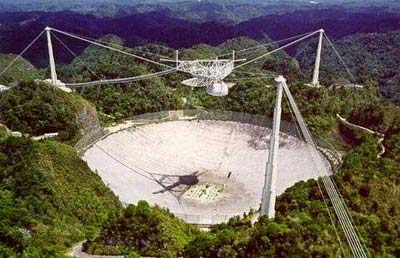Frank Drake, the founder of the scientific search for extraterrestrial civilizations, believes that there are at least 200 advanced civilizations hiding somewhere in our galaxy. Drake’s followers estimate that this number could currently range from 10,000 to 1 million!
The largest computer network in the world is connected to SETI (Search for Extraterrestrial Intelligence). Anyone who downloads the SETI@home program can process data provided by the largest radio telescope in the world located in Arecibo, Puerto Rico. This telescope receives signals from across the galaxy but lacks the time to classify them all. Over 5 million PCs worldwide participate in the project.

SETI Arecibo System (Photo: techno-science)
The most powerful telescopes are aimed at the sky in search of signals of life in the constellations of Cetus, Eridanus, and the number 13 in the constellation Hercules. However, to date, all efforts to find any intelligence in space have ended in failure.
The National Aeronautics and Space Administration (NASA) is conducting a new project called Cyclops, which costs $10 billion. 1,000 telescopes will be installed about 15 km apart. These telescopes will be synchronized to capture “drifting” signals within a range of 1,000 light-years.
Humans have repeatedly attracted the attention of extraterrestrials by sending various messages and objects into deep space. Capsules containing the coordinates of Earth in the galaxy; fundamental physical constants and DNA codes; recordings of Bach’s music; and even images of the Egyptian pyramids have been sent into space aboard spacecraft. Yet, no response has been received from extraterrestrials.
A radio signal from Earth takes up to 10,000 years to reach the nearest stars, so it is still too early to lose patience. Additionally, there are 200 billion stars in a single galaxy. The time required to address global issues depends on advancements in microelectronics and radio telescope technology.
A recent study conducted by Canadian scientists shows that Earth is younger than similar planets in other solar systems by up to 2 billion years. The renowned astronomer Josef Shklovsky is
 |
| Seth Shostak, leading astronomer at the SETI Institute in California (Photo: seti.org) |
one of the active supporters of extraterrestrial civilizations. However, he changed his mind later in life and reached a rather gloomy conclusion: humanity is unique in the universe! And some skeptical scientists share this view.
Seth Shostak, the leading astronomer at the SETI Institute in California, estimates that rapid advancements in these fields will allow humanity to discover intelligent life in our galaxy within the next 20 years. This research could be beneficial for Mars and Europa—a large natural satellite of Jupiter. Collected data indicates that Mars has large reserves of ancient ice and water. However, Mars lacks an atmosphere. Europa’s diameter is exactly four times smaller than Earth.
This satellite was discovered by Galileo in 1610, and a few years ago, the probe named Galileo collected important data about Europa. This moon is covered by a thick layer of ice over an ocean that is 50 km deep. Perhaps Earth and Europa are the only two places in the solar system with vast amounts of water. Additionally, Europa has an atmosphere containing oxygen. Scientists still need to investigate whether the oxygen is biologically sourced like the oxygen on Earth.


















































